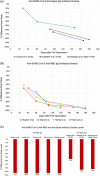Characterization of the significant decline in humoral immune response six months post-SARS-CoV-2 mRNA vaccination: A systematic review
- PMID: 35229324
- PMCID: PMC9088566
- DOI: 10.1002/jmv.27688
Characterization of the significant decline in humoral immune response six months post-SARS-CoV-2 mRNA vaccination: A systematic review
Abstract
Accumulating evidence shows a progressive decline in the efficacy of coronavirus disease 2019 (COVID-19) (severe acute respiratory syndrome coronavirus 2 [SARS-CoV-2]) messenger RNA (mRNA) vaccines such as Pfizer-BioNTech (mRNA BNT161b2) and Moderna (mRNA-1273) in preventing breakthrough infections due to diminishing humoral immunity over time. Thus, this review characterizes the kinetics of anti-SARS-CoV-2 antibodies after the second dose of a primary cycle of COVID-19 mRNA vaccination. A systematic search of the literature was performed and a total of 18 articles (N = 15 980 participants) were identified and reviewed. The percent difference of means of reported antibody titers was then calculated to determine the decline in humoral response after the peak levels postvaccination. Findings revealed that the peak humoral response was reached at 21-28 days after the second dose, after which serum levels progressively diminished at 4-6-month postvaccination. Additionally, results showed that regardless of age, sex, serostatus, and presence of comorbidities, longitudinal data reporting antibody measurement exhibited a decline of both anti-receptor binding domain immunoglobulin G (IgG) and anti-spike IgG, ranging from 94% to 95% at 90-180 days and 55%-85% at 140-160 days, respectively, after the peak antibody response. This suggests that the rate of antibody decline may be independent of patient-related factors and peak antibody titers but mainly a function of time and antibody class/molecular target. Hence, this study highlights the necessity of more efficient vaccination strategies to provide booster administration in attenuating the effects of waning immunity, especially in the appearance of new variants of concerns.
Keywords: COVID-19; Moderna; Pfizer-BioNTech; mRNA 1273; mRNA BNT162b2; vaccines.
© 2022 Wiley Periodicals LLC.
Conflict of interest statement
The authors declare no conflicts of interest.
Figures





References
-
- Albano PM, Notarte KI, Macaranas I, Maralit B. Cross‐contamination in molecular diagnostic laboratories in low‐ and middle‐income countries: a challenge to COVID‐19 testing. Philippine Journal of Pathology. 2020;5:7‐11. 10.21141/PJP.2020.09 - DOI
Publication types
MeSH terms
Substances
Grants and funding
LinkOut - more resources
Full Text Sources
Medical
Miscellaneous

